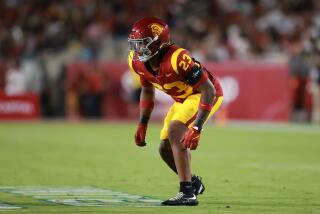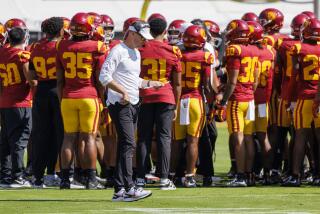Trojans try to get behind enemy line
USC defensive tackle Jurrell Casey abides by a simple philosophy when it comes to stopping running backs such as California’s Jahvid Best.
“If they don’t get to the line, they can’t do anything, right?” Casey said.
That’s the plan USC’s front seven wants to execute Saturday when the seventh-ranked Trojans play No. 24 California at Memorial Stadium in Berkeley.
So far, the strategy has worked fairly well.
Consider:
* USC ranks fifth nationally in rushing defense, giving up only 59.5 yards a game.
* The Trojans are second in tackles for losses, averaging 11 a game.
* Perhaps most impressive, USC is giving up only 1.7 yards per rushing play.
“Scheme-wise and system-wise, I think we’re really on our game,” Coach Pete Carroll said of the front seven. “We know what we’re doing, and these guys can carry it out.”
Many questioned how the Trojans’ front seven would fare after one starting tackle, two ends and three linebackers from last season’s unit moved on to the NFL.
Tackle Fili Moala, ends Clay Matthews and Kyle Moore and linebackers Brian Cushing, Rey Maualuga and Kaluka Maiava are now playing on Sundays.
But sophomore Chris Galippo and juniors Michael Morgan and Malcolm Smith lead a linebacker corps that has been productive behind a deep, talented and young defensive line.
Casey, a sophomore, and junior Christian Tupou are the tackles, junior Everson Griffen and redshirt freshman Wes Horton the starting ends for a defensive line that has thrived under coach Jethro Franklin.
Redshirt freshman Nick Perry has played both end and tackle and leads the Pacific 10 Conference with six sacks. Freshman end Devon Kennard and sophomore end Malik Jackson also have been productive, and senior tackle Averell Spicer is a veteran presence for a defense that ranks second nationally in sacks (4.5 a game) and sixth in total defense (227 yards a game).
“We’ve exceeded our expectations for ourselves and we’re only going to get better,” said Galippo, who leads the team in tackles.
Best is not surprised by the strength of the USC’s rebuilt defense, which also features a veteran secondary.
“They get different faces every year, but they get the same productivity,” he said.
Before last weekend, Best was among college football’s most productive running backs.
The speedy junior scored five touchdowns against Minnesota and was a Heisman Trophy front-runner entering last week’s Pacific 10 Conference opener at Oregon.
Then he gained only 55 yards in 16 carries in the Golden Bears’ 42-3 meltdown -- the first time this season he was held under 131 yards -- but USC is not expecting a repeat performance.
“If you give him too much,” Galippo said, “he’ll take off and beat you.”
That means tackling or cutting off Best before he gets to the line of scrimmage and then forcing him to run toward the sideline.
“You’ve got to hit him in the backfield,” Griffen said. “You’ve got to stop his feet, make him change direction, east to west, and not let him get north and south.” Last year against USC, Best rushed for only 30 yards in 13 carries in a 17-3 defeat at the Coliseum.
It was the fewest points scored by Cal since 2000 and marked the first time during Coach Jeff Tedford’s tenure that the Golden Bears failed to score a touchdown.
“They just dominated the line of scrimmage,” Best said this week.
USC aims to do it again while keeping an eye on Best.
“Just because you have speed,” Casey said, “doesn’t mean you’re going to be able to outrun us.”
--
twitter.com/latimesklein
More to Read
Go beyond the scoreboard
Get the latest on L.A.'s teams in the daily Sports Report newsletter.
You may occasionally receive promotional content from the Los Angeles Times.







